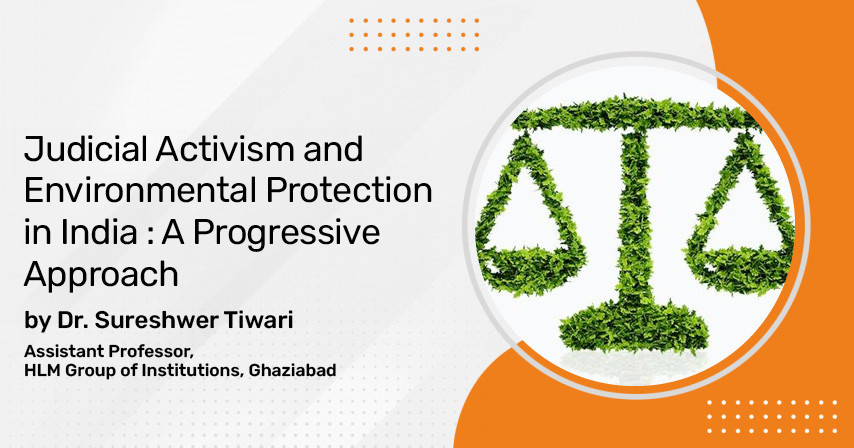
Introduction
Environmental protection has emerged as a critical concern globally, and in India, judicial activism has played a significant role in safeguarding environmental rights. Over the past few decades, the Indian judiciary, particularly the Supreme Court and High Courts, has actively interpreted constitutional provisions to ensure environmental justice. The judiciary has evolved into an environmental watchdog, expanding the traditional boundaries of law and enforcing the principle of sustainable development.
The Intervention of the judiciary in environmental matters through public interest litigations (PILs), landmark judgments, and the application of doctrines like the polluter pays principle, precautionary principle, and intergenerational equity has significantly contributed to the preservation of natural resources. This blog explores the role of judicial activism in environmental protection in India, landmark judgments, the evolution of environmental jurisprudence, and the challenges that persist.
Judicial Activism: Meaning and Scope
Judicial activism refers to the proactive role of the judiciary in enforcing constitutional and legal rights when the executive and legislature fail to act. It involves the interpretation of laws in a liberal and expansive manner to uphold justice, often stepping into domains traditionally reserved for the other two organs of the state.
In the context of environmental protection, judicial activism has ensured:
- The enforcement of environmental laws.
- Recognition of the right to a clean environment as a fundamental right under Article 21 (Right to Life) of the Indian Constitution.
- Expansion of environmental jurisprudence through Public Interest Litigations (PILs).
- Imposition of penalties on industries and individuals violating environmental norms.
Constitutional and Legal Framework for Environmental Protection in India
The Indian Constitution provides a strong foundation for environmental protection. The judiciary has relied on the following constitutional provisions to uphold environmental justice:
Fundamental Rights
- Article 21 (Right to Life): The Supreme Court has interpreted the right to life to include the right to a pollution-free environment.
- Article 32 & Article 226: Empower individuals to file PILs before the Supreme Court and High Courts, respectively, seeking environmental protection.
Directive Principles of State Policy (DPSP)
- Article 48-A: Directs the state to protect and improve the environment and safeguard forests and wildlife.
- Article 47: Obligates the state to improve public health, indirectly emphasizing environmental protection.
Fundamental Duties
Article 51-A(g): Imposes a duty on every citizen to protect and improve the environment, including forests, lakes, rivers, and wildlife.
Environmental Laws
- The Environment Protection Act, 1986
- The Water (Prevention and Control of Pollution) Act, 1974
- The Air (Prevention and Control of Pollution) Act, 1981
- The Forest Conservation Act, 1980
- The Wildlife Protection Act, 1972
- The National Green Tribunal (NGT) Act, 2010
Despite the existence of these laws, judicial intervention has been crucial in ensuring their effective implementation.
Landmark Judgments on Judicial Activism in Environmental Protection
Rural Litigation and Entitlement Kendra v. State of Uttar Pradesh (1985)
This was the first case where the Supreme Court ordered the closure of limestone quarries in Dehradun due to environmental degradation. The court emphasized sustainable development and environmental conservation.
C. Mehta v. Union of India (1986) – The Ganga Pollution Case
Public interest litigator M.C. Mehta filed a case against tanneries polluting the Ganga River. The Supreme Court issued strict orders for pollution control, emphasizing the polluter pays principle.
C. Mehta v. Union of India (1987) – The Oleum Gas Leak Case
Following a gas leak from Shriram Industries, the Supreme Court laid down the absolute liability principle, holding industries responsible for environmental hazards caused by their operations.
Vellore Citizens Welfare Forum v. Union of India (1996)
The Supreme Court recognized the precautionary principle and polluter pays principle as essential components of Indian environmental law.
P. Pollution Control Board v. M.V. Nayudu (1999)
The court highlighted the importance of scientific expertise in environmental matters and stressed the precautionary principle in environmental decision-making.
N. Godavarman Thirumulpad v. Union of India (1996)
This case led to significant judicial intervention in forest conservation, where the Supreme Court interpreted the Forest Conservation Act, 1980, broadly and stopped deforestation in several states.
C. Mehta v. Union of India (1998) – The Delhi Vehicular Pollution Case
The Supreme Court ordered the conversion of Delhi’s public transport system to CNG, reducing air pollution in the capital.
Goa Foundation v. Union of India (2014)
The Supreme Court banned illegal mining in Goa and emphasized sustainable mining practices.
Arjun Gopal v. Union of India (2017)
The Supreme Court imposed restrictions on firecrackers in Delhi to control rising air pollution.
Sterlite Copper Plant Case (2018)
The Tamil Nadu government ordered the closure of the Sterlite Copper plant due to environmental violations, a decision upheld by the courts.
These cases demonstrate how the judiciary has played a crucial role in shaping India’s environmental policies through proactive rulings.
Environmental Doctrines Developed by the Judiciary
Public Trust Doctrine
The Supreme Court, in M.C. Mehta v. Kamal Nath (1997), held that the government is a trustee of natural resources and must protect them for public use.
Polluter Pays Principle
Recognized in the Vellore Citizens Welfare Forum case (1996), this principle mandates that the polluter bears the cost of environmental damage.
Precautionary Principle
The courts have emphasized the need to take preventive measures even if there is no scientific certainty about environmental harm.
Sustainable Development
The Supreme Court has consistently upheld the balance between environmental protection and economic growth.
Absolute Liability
Developed in the Oleum Gas Leak Case, this doctrine holds industries strictly liable for environmental harm, regardless of negligence.
Role of the National Green Tribunal (NGT) in Judicial Activism
The National Green Tribunal (NGT), established in 2010, has become a major forum for environmental litigation. The NGT has delivered several landmark judgments, including:
- Banning illegal sand mining in rivers.
- Imposing heavy penalties on polluting industries.
- Regulating waste management and construction activities.
- The NGT has significantly strengthened environmental governance in India.
Challenges in Judicial Activism for Environmental Protection
Despite judicial efforts, several challenges persist
- Lack of enforcement – Many judicial orders remain unimplemented due to bureaucratic inefficiencies.
- Conflict with economic development – Industries and governments often argue that strict environmental regulations hinder economic growth.
- Delayed justice – Environmental cases sometimes take years for resolution.
- Weak compliance mechanisms – Even after judgments, polluting industries often continue their operations.
- Political resistance – Governments sometimes overlook environmental concerns due to political and economic interests.
Future Prospects and Recommendations
- Judicial activism has undoubtedly played a crucial role in environmental protection, but further improvements are necessary:
- Strengthening environmental courts like the NGT with more powers.
- Enhancing judicial monitoring mechanisms to ensure compliance with court orders.
- Encouraging alternative dispute resolution (ADR) mechanisms for environmental conflicts.
- Public awareness and participation to ensure collective responsibility for environmental protection.
- Government and judiciary collaboration to integrate environmental policies into national development plans.
Conclusion
Judicial activism in India has transformed environmental jurisprudence and provided strong legal precedents for environmental protection. The judiciary has played an essential role in interpreting constitutional provisions expansively, enforcing environmental laws, and holding polluters accountable. While challenges remain, continued judicial intervention, coupled with effective governance and public participation, can ensure a sustainable and pollution-free future for India.
The evolving role of the judiciary in environmental matters highlights the dynamic nature of environmental law, ensuring that justice is not just limited to humans but extends to nature itself. As environmental challenges grow, the judiciary’s proactive stance will remain a cornerstone of India’s environmental protection efforts.
